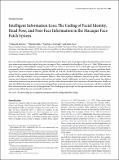| dc.contributor.author | Meyers, Ethan M. | |
| dc.contributor.author | Borzello, Mia | |
| dc.contributor.author | Freiwald, Winrich A. | |
| dc.contributor.author | Tsao, Doris | |
| dc.date.accessioned | 2016-01-12T14:03:34Z | |
| dc.date.available | 2016-01-12T14:03:34Z | |
| dc.date.issued | 2015-05 | |
| dc.date.submitted | 2015-03 | |
| dc.identifier.issn | 0270-6474 | |
| dc.identifier.issn | 1529-2401 | |
| dc.identifier.uri | http://hdl.handle.net/1721.1/100798 | |
| dc.description.abstract | Faces are a behaviorally important class of visual stimuli for primates. Recent work in macaque monkeys has identified six discrete face areas where most neurons have higher firing rates to images of faces compared with other objects (Tsao et al., 2006). While neurons in these areas appear to have different tuning (Freiwald and Tsao, 2010; Issa and DiCarlo, 2012), exactly what types of information and, consequently, which visual behaviors neural populations within each face area can support, is unknown. Here we use population decoding to better characterize three of these face patches (ML/MF, AL, and AM). We show that neural activity in all patches contains information that discriminates between the broad categories of face and nonface objects, individual faces, and nonface stimuli. Information is present in both high and lower firing rate regimes. However, there were significant differences between the patches, with the most anterior patch showing relatively weaker representation of nonface stimuli. Additionally, we find that pose-invariant face identity information increases as one moves to more anterior patches, while information about the orientation of the head decreases. Finally, we show that all the information we can extract from the population is present in patterns of activity across neurons, and there is relatively little information in the total activity of the population. These findings give new insight into the representations constructed by the face patch system and how they are successively transformed. | en_US |
| dc.description.sponsorship | National Science Foundation (U.S.) (STC Center for Brains, Minds and Machines Award CCF-1231216) | en_US |
| dc.description.sponsorship | National Institutes of Health (U.S.) (Grant R01-EY021594) | en_US |
| dc.description.sponsorship | Pew Charitable Trusts (Scholarship in the Biomedical Sciences) | en_US |
| dc.language.iso | en_US | |
| dc.publisher | Society for Neuroscience | en_US |
| dc.relation.isversionof | http://dx.doi.org/10.1523/jneurosci.3086-14.2015 | en_US |
| dc.rights | Creative Commons Attribution | en_US |
| dc.rights.uri | http://creativecommons.org/licenses/by/4.0/ | en_US |
| dc.source | Society for Neuroscience | en_US |
| dc.title | Intelligent Information Loss: The Coding of Facial Identity, Head Pose, and Non-Face Information in the Macaque Face Patch System | en_US |
| dc.type | Article | en_US |
| dc.identifier.citation | Meyers, E. M., M. Borzello, W. A. Freiwald, and D. Tsao. “Intelligent Information Loss: The Coding of Facial Identity, Head Pose, and Non-Face Information in the Macaque Face Patch System.” Journal of Neuroscience 35, no. 18 (May 6, 2015): 7069–7081. | en_US |
| dc.contributor.department | Center for Brains, Minds and Machines at MIT | en_US |
| dc.contributor.department | Massachusetts Institute of Technology. Department of Brain and Cognitive Sciences | en_US |
| dc.contributor.department | McGovern Institute for Brain Research at MIT | en_US |
| dc.contributor.mitauthor | Meyers, Ethan M. | en_US |
| dc.contributor.mitauthor | Borzello, Mia | en_US |
| dc.contributor.mitauthor | Freiwald, Winrich A. | en_US |
| dc.relation.journal | Journal of Neuroscience | en_US |
| dc.eprint.version | Final published version | en_US |
| dc.type.uri | http://purl.org/eprint/type/JournalArticle | en_US |
| eprint.status | http://purl.org/eprint/status/PeerReviewed | en_US |
| dspace.orderedauthors | Meyers, E. M.; Borzello, M.; Freiwald, W. A.; Tsao, D. | en_US |
| mit.license | PUBLISHER_CC | en_US |
